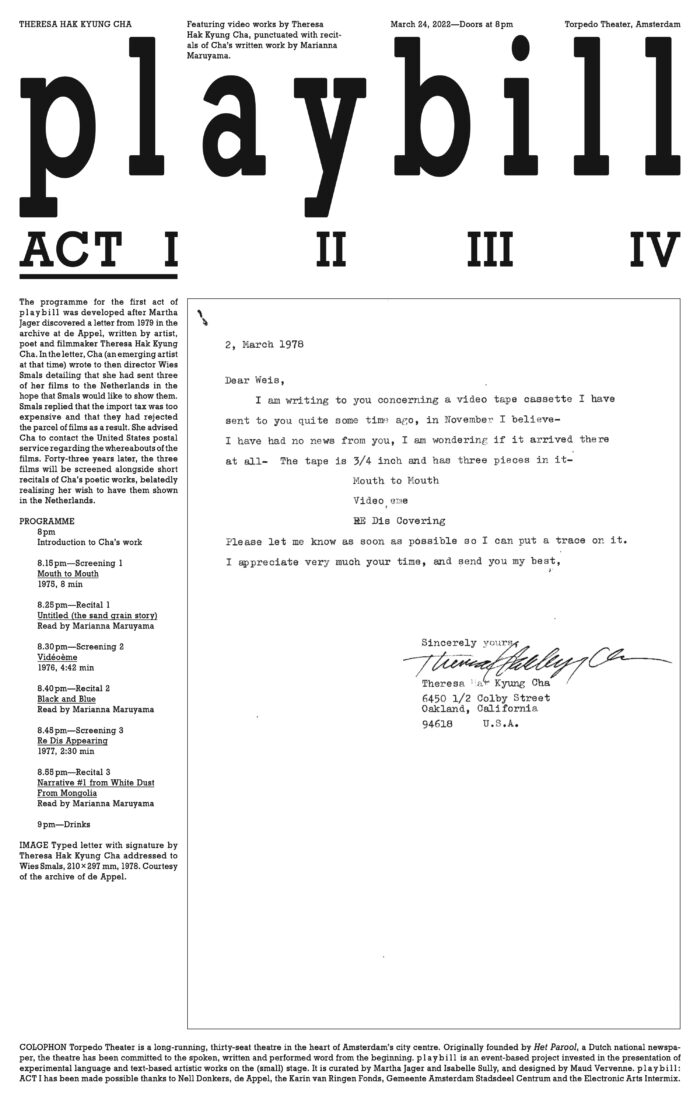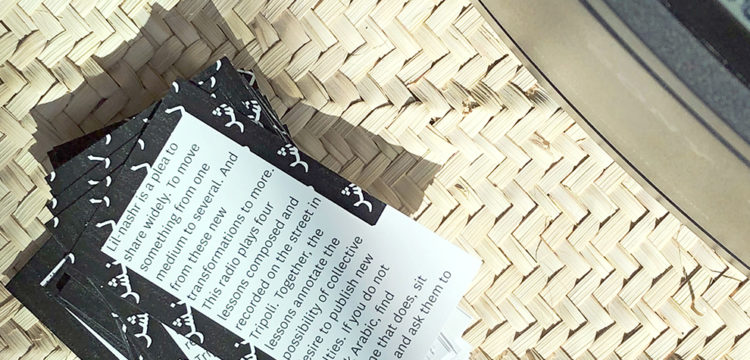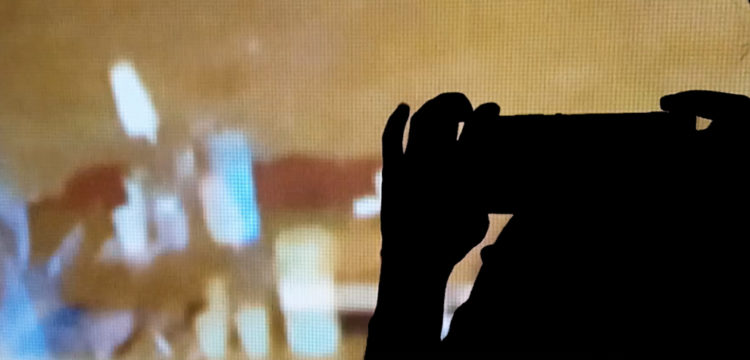A Playbill
Experimental language and text-based artistic works on a (small) stage
Playbill is a series of events curated by Martha Jager and Isabelle Sully at Torpedo Theater in Amsterdam, a long-running, small-scale, thirty-seat theater in the heart of Amsterdam’s city center. Originally founded by Het Parool, the Dutch national newspaper, the theater has been committed to the spoken, written and performed word from the beginning. Drawing a connection to the theater’s history with print media, Playbill is an event-based project invested in the presentation of experimental language and text-based artistic works on the (small) stage. Finding Torpedo—the smallest theater in the Netherlands—played a big part in the shaping of the program and direction of Playbill. Originally built as a puppet theater, the intimacy of the small stage and the thirty-seat capacity sits at the center of the project.
Each ‘act’ of Playbill consists of a live event and a printed playbill. The playbill stands as the programme for the event while also bringing together related (archival) material. Through each edition, it will build the archive of Playbill—with a nodd to the seriality of the programme embedded in the design itself. Again drawing on processes associated with print media, the playbills will be produced using risograph and will take the size and shape of the traditional tabloid layout. Doubling as a poster, they can also be glued in public space—an activity typical to promoting live acts.
Playbill’s identity, designed by Maud Vervenne, draws on a quote set in a block typeface sitting above the small bar at the back of Torpedo Theater. Most commonly used by newspapers, the block typeface has been customised specifically for Playbill, nodding to the theatre’s history of belonging to the resistance newspaper Het Parool—a history also present in the quote, which translates to ‘Free, without fear’.
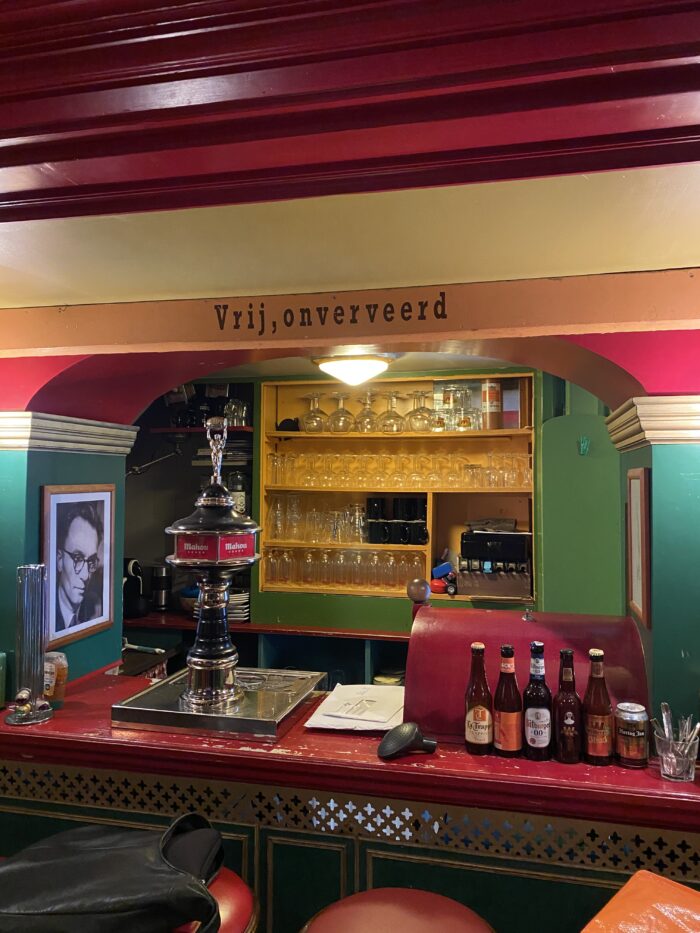
Some while ago, I read on Instagram my friend Isabelle Sully’s announcement about the project. I thought I’d been to the Torpedo Theater before, so I’ve googled it. I couldn’t really figure the exact capacity of the thirty-seat space out of my head. As I found the very colorful photos I’ve realized that no—I have never actually been. As it was being pre-announced, this specific event was already causing me some fomo: curated by two dear friends, at the intersection of performance and publishing—with such a great title, in this incredible location—and by coincidence I was also finally reading Dictee, one of the most influential poetry books of last century. So, I thought, how can I get closer, if I can’t travel there?
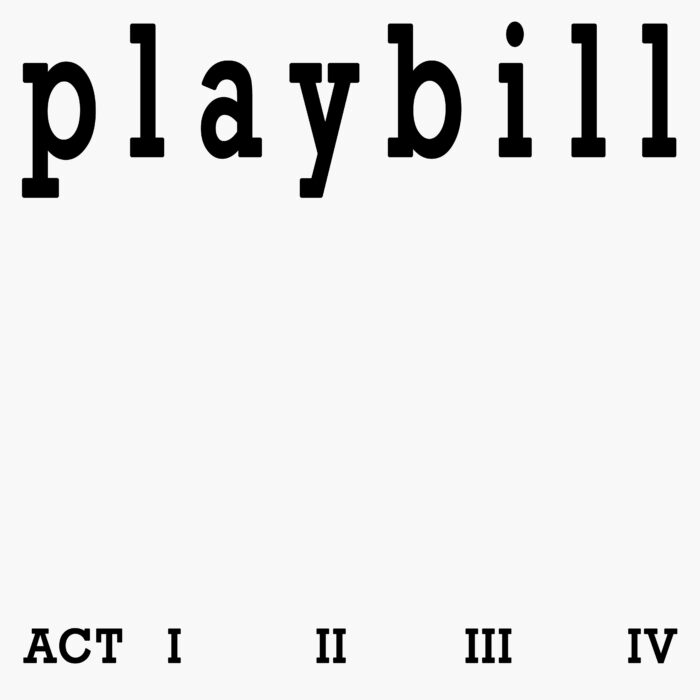
Giulia Crispiani: Well, you may be wondering why a description as short as the one you provided for Playbill triggered my attention in the first place? It’s most likely because of the two of you, but also because I have a fascination with the object itself: the playbill, meant as something absolutely summary but also as an invitation to come in. How did it come about?
Martha Jager: When Isabelle and I found out we were both researching the work of Theresa Hak Kyung Cha—her for the exhibition Between the Teeth at Manifold Books and me for The Remote Archivist, a publication project by the archive of de Appel—we started talking about the different materials and thought it would be great to organise an event where our research and our mutual interest in text-based practices, administration, correspondence and ego-documents could meet. This developed into the idea for a series of events, or ‘acts’ as we call them, which we now envision as a two-year project that will present text-based work, but specifically those practices which we feel have gone overlooked or don’t enjoy the appreciation we feel it should. The name Playbill, and the use of a playbill as a form of publishing, followed after finding a location for the event series: the Torpedo Theater in Amsterdam, the smallest theater in the Netherlands. We chose this theater because of its history with print but also because it only seats thirty people, and surprisingly (due to its size) lacks the fourth wall often present in theater, which makes for a sense of intimacy and offers interesting conditions to play and connect with. This scale is really key to the project. Then, the playbill for each event, designed by Maud Vervenne as part of the project’s identity, will hold the programme as well as (archival) documents related to the event, or in the case of the first act, which led to the event. In that sense it serves as a platform for that which often goes unseen (administration, correspondence, ego-documents) and doubles as an invitation, as well as a growing (and accessible) archive of the project.
Giulia Crispiani: What is a theater and what is Theater? Which of the two are you using?
Isabelle Sully: This is such a classically Giulia question and I love it. Personally, I am interested in ‘Theater’ when it comes to this project, but only to a certain extent. I see Theater as the architecture of performance, one that encompasses the dramatic act as well as the contributing factors that come together to enable that to happen, factors which also belong to a theater (like lighting or seating). Coming from a background in Institutional Critique and having a deep love for reality TV (two things that I don’t at all see as mutually exclusive, given that both are concerned with surpassing the limits of the frame, or reconfiguring an image from the inside out), the mechanics of Theatre are definitely present in my interests with Playbill and in staging text-based works, ones also not necessarily always intended for the stage. In this sense, I see the theater as a site where these things can play out, where the Theatre of it all can happen, or not. Given this interest in a theater as a frame of mediation or action, Theatre can then easily be seen as an editorial process, when talking about working with text. Language is handled, memorised, delivered and received on the stage. It is interesting to me to explore this side of Theater through Playbill: the theater as a site of publication. Particularly when, in the case of Playbill, the history of this specific theater is one entangled with print and publishing, given that it used to be owned by a national newspaper.
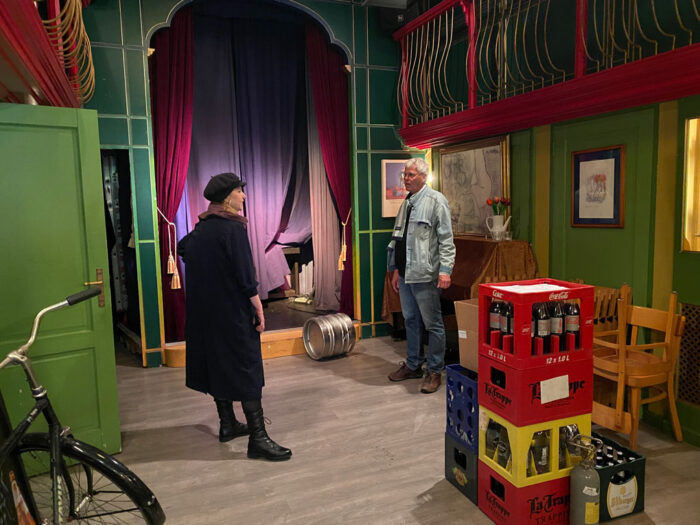
Giulia: A playbill is usually something that’s outside, whilst you say that the presentation happens inside, on the (small) stage of the Torpedo Theater. How much can you anticipate of the format?
Martha: Ha! A playbill by any other name… A playbill, as I understand it, usually is a leaflet or booklet that is given to members of the audience to provide them with information on a play. It includes the programme, breaks and information on the cast and venue, usually topped off with heavy advertising. Personally I am interested in playing with the formats of that which is supposed to take place on the stage and that which (merely) exists to inform it. What if the extra information ís, or becomes, the play or piece? I think this playing with formats, and the investigating of structures of presentation, staging and restaging, will be evident in all events to come out of the project albeit in different ways and to serve different purposes. So rather than turning work and material that was not conceived for the stage into plays, I think what we are interested in is how these works can function within a theatrical setting. Or vice versa, how the theater functions when presenting these works.
Isabelle: I would also just add to this that, as many theatregoers and makers would know, there is quite a famous magazine from the US called Playbill. When we learnt of this, rather than rushing to rename, we thought it was a nice coincidence that there is already a publication of that name, particularly when we are developing a project that will bring the tools of publishing in conversation with the site of the theater and the live act. As an instance of publication, the playbill has a number of functions: it advertises, and therefore attracts audiences, it informs, and therefore provides credit, and it archives, therefore documenting an event in time. As Martha says, these elements of publication that come together to pull focus on what is happening on the stage are part of it too—for us, the format of the playbill anticipates an extension of where the activity is happening.
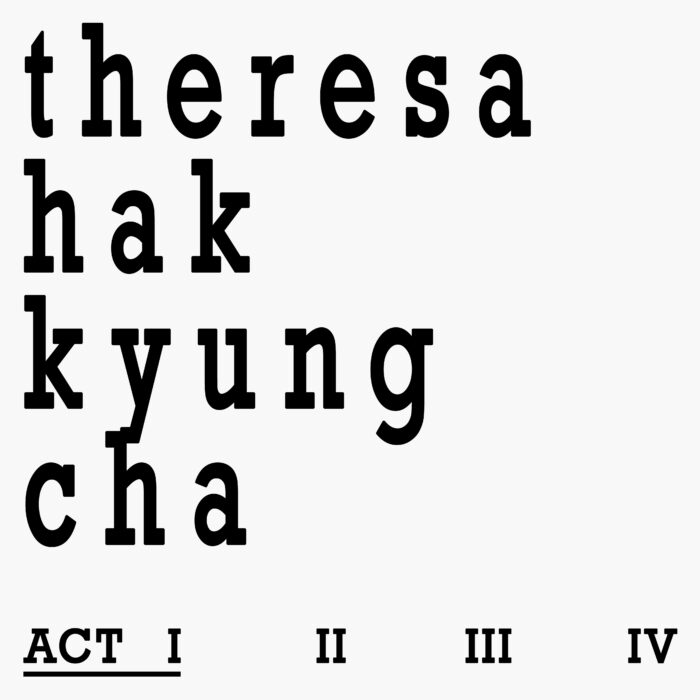
Giulia: The first contribution will be Theresa Hak Kyung Cha (WOW). In what sort of way can a live performance space welcome some posthumous material?
Isabelle: This is a really interesting question. I certainly will betray my naivety when it comes to the history of theater when I say this, but I do have a general feeling that as a discipline there is a lot more restaging of works occurring than, say, in the visual arts. Scripts get adapted and reinterpreted all the time, there seems to be more of an inherent understanding of the notion of the public domain in this sense. When it comes to art, there is much more of an impulse towards upholding the borders of ownership around works. Taking cues from theater around how to work with posthumous or simply pre-existing material provides an interesting proposition for the sphere of art. Then the task becomes an ethical one, how do things like adaptation and interpretation play out while remaining true to the work? In the case of Theresa Hak Kyung Cha, this feels particularly complex given that the conditions within which the work was made are often quite contextual and also deeply personal. How do you handle the material in a way that is respectful to the intentions of its maker and which carries the work’s history (much like how adaptation might operate in theater)? This is something further complexified by the fact that it is being done, as you say, posthumously. Given the circumstances of Cha’s death—which can easily sensationalise her body of work—the context of the theater, a place doused in theatrics, makes it all the more necessary to handle the work with care. With these concerns in mind, we wanted to be straightforward: Martha found a letter that Cha wrote to the director of de Appel in 1978 stating that she had sent three of her films to the Netherlands in the hope that they would be shown. The director rejected them as the customs tax was too high and they have, as far as we know, never been shown here. We interpreted the letter as an invitation and expression of desire on Cha’s part, and are screening the three films in the order in which she wrote them. To bring a live element to the event we have also invited a Dutch-based artist named Marianna Maruyama, who has been invested in Cha’s work for some time, to recite three of Cha’s poetic works. Minimal theatrics in this case, rather, the small theater as an intimate place to gather to see work that should have been shown here years ago.
Martha: Thank you for this question as it is a very important one, and one I feel should be asked again and again in the process of working with and presenting posthumous material. I think there are several ways in which a live art setting can welcome posthumous material, for which the most straightforward way is that of scripted works and/or re-enactments. In the case of Playbill we are not necessarily invested in re-enactments but rather the performance of material and the act of presenting. In the case of Theresa Hak Kyung Cha we are screening three films that have been screened before, but it’s the connection to the letter by Theresa to de Appel that makes for the specific conditions, or to speak in theatrical terms, the setting of the stage.
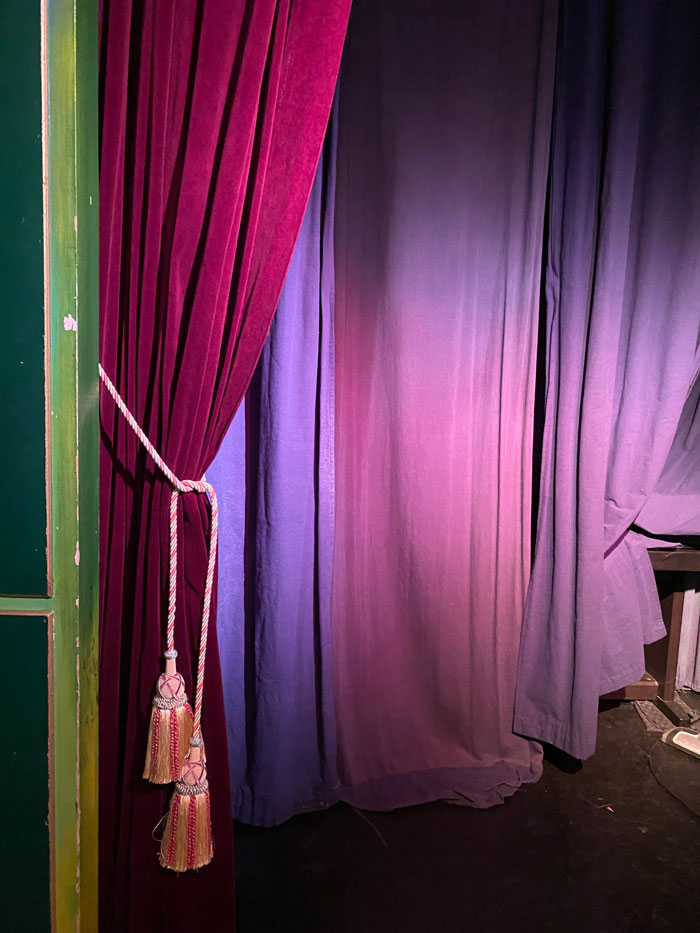
Giulia: What’s upcoming and how often?
Isabelle: We have planned four acts for the coming year, and hope to continue programming in this manner at Torpedo for the following year(s) too. So, the year as a four-act play, shall we say. We can’t officially say what else is coming just yet, but we can share that we are interested in how different types of text and its treatment might play out on the stage. With the first act focusing on Theresa Hak Kyung Cha’s poetic and video works—a more straightforward screening and recital—we are interested in other forms of site-specific textual delivery for the upcoming events, such as a theatrical monologue, a musical score and a live translation.
Martha: As Isabelle said, the programme for this year has been planned, meaning we know which artists we will focus on, but how this will unfold exactly will depend on what we find during research in the archives we will visit. Looking at work and going through archives, with the theater as a setting mind, provides an interesting and specific lens through which we perceive what we find. In the case of the first act, I would say there is still a sense of restaging as we are acting upon a request by her from 1979. In the following three acts, where we will look at works by three other artists, we will look into different ways of presenting text-based works. This will include material intended to be performed but also (performative) narration of (found) material. Something which we did not anticipate, but that will inform all acts in some way or another, is the relationship of the featured artists and works to certain locations in Amsterdam.
